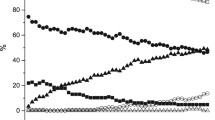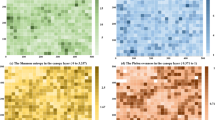Abstract
Understanding the mechanisms of assembly of tree communities is very important for restoring and managing pine-oak mixed forests in the Qinling Mountains, China, but the essential mechanisms remain largely unexplored. The objective of this research was to uncover the underlying mechanisms of species coexistence and to identify the key environmental factors influencing the tree community assemblages in these forests. We investigated tree species and 15 environmental factors of topography, soil properties, and stand development of pine-oak mixed forests at an elevation of 1000-2000 m a.s.l. in the Qinling Mountains. Six classical models for the distribution of species abundance were used to fit the observed distributions; a clustering analysis was conducted to divide the ecological species groups, and a redundancy analysis examined the relationship between species assemblages and various environmental factors. Zipf-Mandelbrot, neutral-theory, log-normal, and Zipf models performed well in fitting the patterns of species-abundance distribution in the pine-oak mixed forests, which was related to the complexity of the community structure of the forests. A special combination of the Zipf-Mandelbrot and neutral-theory models, however, best explained the mechanism of species coexistence for the forests and indicated that these forests were progressive successional communities able to maintain stable development during succession. In addition, multiple factors controlled the tree community assemblage of pine-oak mixed forests in the mountainous regions, although available potassium, slope aspect, average tree DBH, and slope position were significant environmental variables.
Similar content being viewed by others
References
Albert BM (2007) Climate, fire, and land-use history in the oak-pinehickory forests of northeast texas during the past 3500 years. Castanea 72:82–91
Aoyagi R, Imai N, Kitayama K (2013) Ecological significance of the patches dominated by pioneer trees for the regeneration of dipterocarps in a Bornean logged-over secondary forest. Forest Ecol Manag 289:378–384
Basset Y, Novotny V, Miller SE, Springate ND (1998) Assessing the impact of forest disturbance on tropical invertebrates: some comments. J Appl Ecol 35:461–466
Bieng MAN, Perot T, de Coligny F, Goreaud F (2013) Spatial pattern of trees influences species productivity in a mature oak-pine mixed forest. Eur J Forest Res 132:841–850
Broncano MJ, Riba M, Retana J (1998) Seed germination and seedling performance of two mediterranean tree species, holm oak (Quercus ilex L. and aleppo pine (Pinus halepensis Mill.): A multifactor experimental approach. Plant Ecol 138:17–26
Chai ZZ, Wang DX (2016) Environmental influences on the successful regeneration of pine-oak mixed forests in the Qinling Mountains, China. Scand J Forest Res 31:368–381
Chai ZZ, Wang DX (2016) A comparison of species composition and community assemblage of secondary forests between the birch and pine-oak belts in the mid-altitude zone of the Qinling Mountains, China. PeerJ 4:e1900
Cheng F, Peng X, Zhao P, Yuan J, Zhong C, Cheng Y, Cui C, Zhang S (2013) Soil Microbial Biomass, Basal Respiration and Enzyme Activity of Main Forest Types in the Qinling Mountains. Plos One 8:e67353
Connolly SR, Thibaut LM (2012) A comparative analysis of alternative approaches to fitting species-abundance models. J Plant Ecol-UK 5:32–45
Curtis JT, Mclntosh RP (1951) An upland forest continuum in the prairie-forest border region of Wisconsin. Ecology 32:476–496
Dang KL, Lei RD, Zhang SX (1996) Soil characteristics of sharp tooth oak forest between pine and oak on south-facing slope of Qingling Mountians. Journal of Northwest Forest College 11:127–131
Dullinger S, Dirnbock T, Grabherr G (2004) Modelling climate change-driven treeline shifts: Relative effects of temperature increase, dispersal and invasibility. J Ecol 92:241–252
Filho RC, Martins FR, Gneri MA (2002) Fitting abundance distribution models in tropical arboreal communities of SE Brazil. Community Ecol 3:169–180
Forrester DI, Smith RGB (2012) Faster growth of eucalyptus grandis and eucalyptus pilularis in mixed-species stands than monocultures. Forest Ecol Manag 286:81–86
Frontier S (1985) Diversity and structure in aquatic ecosystems. Oceanogr Mar Biol Ann Rev 23:253–312
Frontier S (1987) Applications of fractal theory to ecology. In: Legender, P. (ed) Developents in Numerical Ecology, pp.357–378. Springer-Verlag, Berlin
Geng ZC, Liu LL, Bi CX (1999) A primary study on soil enzyme activietes in sharp tooth oak forest and mixed stands on southfacing slope of the Qinling Mountains. Journal of Northwest Forest College 14:64–67
Gilliam FS, Platt WJ (1999) Effects of long-term fire exclusion on tree species composition and stand structure in an old-growth pinus palustris (longleaf pine) forest. Plant Ecol 140:15–26
Gomez-Mendoza L, Arriaga L (2007) Modeling the effect of climate change on the distribution of oak and pine species of mexico. Conser Biol 21:1545–1555
Gotellli NJ, Colwell RK (2001) Quantifying biodiversity: procedures and pitfalls in measurement and comparison of species richness. Ecol Lett 4:379–391
Gracia M, Retana J, Roig P (2002) Mid-term successional patterns after fire of mixed pine-oak forests in ne spain. Acta Oecol 23:405–411
Hankin RKS (2007) Introducing untb, an R package for simulating ecological drift under the unified nuetral theory of biodiversity. J Stat Softw 22(12)
Hejcman M, Ceskova M, Schellberg J, Patzold S (2010) The rengen grassland experiment: Effect of soil chemical properties on biomass production, plant species composition and species richness. Folia Geobot 45:125–142
Hill JK, Hamer KC (1998) Using species abundance models as indicators of habitat disturbance in tropical forests. J Appl Ecol 35:458–460
Hong SK, Nakagoshi N, Kamada M (1995) Human impacts on pinedominated vegetation in rural landscapes in korea and western japan. Vegetatio 116:161–172
Hubbell SP (2001) The unified neutral theory of biodiversity and biogeography. Princeton Univ Press Princeton
Jacqmain EI, Jones RH, Mitchell RJ (1999) Influences of frequent cool-season burning across a soil moisture gradient on oak community structure in longleaf pine ecosystems. Am Midl Nat 141:85–100
Kang B, Wang DX, Cui HA (2011) Regeneration characteristics and related affecting factors of pinus tabulaeformis secondary forests in qinling mountains. Chinese Journal of Applied Ecology 22:1659–1667
Krebs CJ (1978) Ecology: The experimental analysis of distribution and abundance, 2nd ed. New York: Harper & Row Publishers
Kronzucker HJ, Siddiqi MY, Glass ADM (1997) Conifer root discrimination against soil nitrate and the ecology of forest succession. Nature 385:59–61
Lei RD, Peng H, Chen CG (1996) Types and phytoenosis of natural secondary forests at huoditang forest region. Journal of Northwest Forest College 11:43–52
Lin G, Stralberg D, Gong G, Huang Z, Ye W, Wu L (2013) Separating the effects of environment and space on tree species distribution: From population to community. Plos One 8
Liu GQ, Tu XN, Zhao SD, Sun SH, Gravenhorst G (2001) Distributional characteristics on biomass and nutrient elements of pine-oak forest belt in mt. Qinling Scientia Silvae Sinicae 27:28–36
Liu XP, Zhang WJ, Yang F, Zhou X, Liu ZJ, Qu F, Lian SQ, Wang CL, Tang XG (2012) Changes in vegetation-environment relationships over long-term natural restoration process in middle taihang mountain of north china. Ecol Eng 49:193–200
Lomolino MV (2001) Elevation gradients of species-density: historical and prospective views. Global Ecol Biogeogr 10:3–13
MacArthur RH (1957) On the relative abundance of bird species. Proceedings of the National Academy of Sciences, USA 43: 293–295
Matthews TJ, Whittaker RJ (2014) Neutral theory and the species abundance distribution: Recent developments and prospects for unifying niche and neutral perspectives. Ecol Evol 4:2263–2277
McGill BJ, Etienne RS, Gray JS, Alonso D, Anderson MJ, Benecha HK, Dornelas M, Enquist BJ, Green JL, He FL, Hurlbert AH, Magurran AE, Marquet PA, Maurer BA, Ostling A, Soykan CU, Ugland KI, White EP (2007) Species abundance distributions: moving beyond single prediction theories to integration within an ecological framework. Ecol Lett 10:995–1015
Motomura I (1932) On the statistical treatment of communities. Zool Mag 44:379–383
Norris JL, Pollock KH (1998) Non-parametric mle for poisson species abundance models allowing for heterogeneity between species. Environ Ecol Stat 5:391–402
Oksanen J, Kindt R, Legendre P, O'Hara B, Simpson GL, Solymos P, Henry M, Stevens H, Wagner H (2008) Vegan: community ecology package. R package version 1.15–0; Available at: http://cran.r-project.org/, http://vegan.r-forge.r-project.org/
Paluch JG, Bartkowicz LE (2004) Spatial interactions between scots pine (pinus sylvestris L.), common oak (Quercus robur L. and silver birch (Betula pendula Roth). as investigated in stratified stands in mesotrophic site conditions. Forest Ecol Manag 192:229–240
Park AD (2001) Environmental influences on post-harvest natural regeneration in mexican pine-oak forests. Forest Ecol Manag 144:213–228
Parshall T, Foster DR, Faison E, MacDonald D, Hansen BCS (2003) Long-term history of vegetation and fire in pitch pine-oak forests on cape cod, massachusetts. Ecology 84:736–748
Paudel S, Vetaas OR (2014) Effects of topography and land use on woody plant species composition and beta diversity in an arid trans-himalayan landscape, nepal. J Mt Sci-Engl 11:1112–1122
Pielou EC (1975) Ecological Diversity. Wiley, New York
Pigolotti S, Cencini M (2013) Species abundances and lifetimes: From neutral to niche-stabilized communities. J Theo Biol 338:1–8
Preston F (1948) The commonness and rarity of species. Ecology 29:254–283
Pretzsch H, Block J, Dieler J, Dong PH, Kohnle U, Nagel J, Spellmann H, Zingg A (2010) Comparison between the productivity of pure and mixed stands of norway spruce and european beech along an ecological gradient. Ann Forest Sci 67:712
Puerta-Pinero C, Gomez JM, Valladares F (2007) Irradiance and oak seedling survival and growth in a heterogeneous environment. Forest Ecol Manag 242:462–469
R Core Team (2015) R: a language and environment for statistical computing. Vienna: R Foundation for Statistical Computing. Available at: http://www.R-project.org/
Walker SC, Cyr H (2007) Testing the standard neutral model of biodiversity in lake communities. Oikos 116:143–155
Washburn CSM, Arthur MA (2003) Spatial variability in soil nutrient availability in an oak-pine forest: Potential effects of tree species. Can J Forest Res 33:2321–2330
Wilson JB (1991) Methods for fitting dominance/diversity curves. J Veg Sci 2:35–46
Wolf JHD (2005) The response of epiphytes to anthropogenic disturbance of pine-oak forests in the highlands of chiapas, mexico. Forest Ecol Manag 212:376–393
Wu H, Wang DX, Hu YN, Huang QP (2012) Numerical classfication and ordination of pine and oak mixed forest communities in the middle part of qingling mountains. Acta Bot Borea Occident Sin 32:1671–1679
Wu H, Wang DX, Huang QP, Zhang Y, Song B (2012) Influence of environmental factors on species diversity of pine-oak mixed forest communities in the middle part of south qingling mountains. Journal of northwest A&F University (Nat Sci Ed) 40:41–50
Xiao CY, Huang QC, Yuan HH (2002) Characteristics of decomposition of litter fron pine, oak and pine-oak mixed forests. Acta Pedologica Sinica 35:763–767
Xu HC (1990) Chinese pine, Beijing: forestry publisher house of China
Xu YJ, Chen Y, Li WH, Fu AH, Ma XD, Gui DW, Chen YP (2011) Distribution pattern of plant species diversity in the mountains Region of Ili River Valley, Xinjinag. Environ Monit Assess 177:681–694
Yu F, Wang DX, Yi XF, Shi XX, Huang YK, Zhang HW, Zhang XP (2014) Does animal-mediated seed dispersal facilitate the formation of pinus armandii-quercus aliena var. Acuteserrata forests? PLoS One 9:e89886
Yu F, Wang DX, Shi XX, Yi XF, Huang QP, Hu YN (2013) Effects of environmental factors on tree seedling regeneration in a pine-oak mixed forest in the Qinling Mountains, China. J Mt Sci-Engl 10:845–853
Zavala MA, Zea E (2004) Mechanisms maintaining biodiversity in mediterranean pine-oak forests: Insights from a spatial simulation model. Plant Ecol 171:197–207
Zhang F, Zhang JT (2003) Pattern of forest vegetation and its environmental interpretation in zhu weigou,lishan mountain nature reserve. Acta Pedologica Sinica 23:422–427
Zhang HW, Yu F, Wang DX, Zhang ZL (2014) Changes of species composition and diversity in the process of community succession of pine oak forests on the south-facing slopes in qinling mountains. Avta Bot Boreal-Occident Sin 34:169–176
Zhang SL, Liang CP (2012) Effect of a native forest canopy onrainfall chemistry in china's qingling mountains. Environ Earth Sci 67:1503–1513
Zhao XG, Ma CH, Xiao L (2014) The vegetation history of Qinling Mountains, China. Quatern Int 325:55–62
Author information
Authors and Affiliations
Corresponding author
Rights and permissions
About this article
Cite this article
Chai, Z., Fan, D. & Wang, D. Environmental factors and underlying mechanisms of tree community assemblages of pine-oak mixed forests in the Qinling Mountains, China. J. Plant Biol. 59, 347–357 (2016). https://doi.org/10.1007/s12374-015-0503-0
Received:
Accepted:
Published:
Issue Date:
DOI: https://doi.org/10.1007/s12374-015-0503-0




